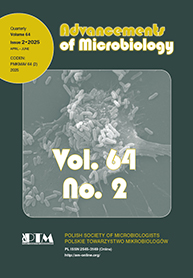Abstract: Skin, the largest organ in the human body, presents the largest possible area for colonization by microorganisms. The aspects of the interaction between microbiota and the host cannot be omitted during procedures in a beauty studio. Professional cosmetologists should consider their work’s impact on skin biodiversity and know the probable consequences. This review reviewed the current state of the art on skin microbiota with a focus on the connection between body area, microbiological biodiversity and the outcome of cooperation between the host and microorganisms. The role of the skin microbiota in maintaining the host’s homeostasis was also summarized.
All posts by Anna Białecka
Abstract: Neisseria gonorrhoeae (gonococcus) is a human pathogen, the aetiological agent of gonorrhoea, which is the second most common bacterial sexually transmitted disease (STD) in the world. The structure of N. gonorrhoeae cell wall is typical of Gram-negative bacteria, poses variable antigens porin B (PorB), and opacity-associated proteins (Opa proteins), lipooligosaccharide (LOS) and type IV pili (TFP) playing an essential role in pathogenesis. In addition to adhesins, gonococcus presents other virulence factors such as reducing modifiable protein (Rmp), iron transporters, membrane pumps, and IgA peptidase. The pathogen produces outer membrane vesicles (OMVs), releases peptidoglycan (PG) fragments and is well adapted to develop infection in diverse niches of the female and male reproductive tracts. The characteristic genotypic trait of N. gonorrhoeae is the state of natural competence, which allows DNA uptake from the environment. The antigenic and phase variability is essential to gonococcal defence against the human immune system. Because of the increasing antimicrobial resistance (AMR) of N. gonorrhoeae and the high incidence rate of gonococcal infections, developing an anti-gonococcal vaccine has become an urgent need. Vaccine development difficulties are mainly due to the gonococcal ability of immune evasion, the lack of an animal model, and the limited understanding of protective immune response mechanisms.
Abstract: Neisseria gonorrhoeae is an aetiological agent of gonorrhoea, which is a sexually transmitted disease (STD), a public health challenge worldwide. Gonorrhoea is undoubtedly a serious health risk, especially for women, due to its often asymptomatic course and the possibility of upper genital tract complications such as pelvic inflammatory disease (PID), which can result in infertility. The data show that the diagnostic method for N. gonorrhoeae should be specific, simple, sensitive, rapid and inexpensive. Currently, phenotypic identification methods have been dominated by NAAT methods, which allow detection and identification of gonococcus directly in the clinical specimen. However, up today molecular methods do not allow full determination of drug susceptibility.
Abstract: Autoimmune diseases, such as rheumatoid arthritis (RA), are examples of yet not entirely understood etiology. They are linked to immune system dysfunction, which becomes immunologically overactive, damaging the body’s tissues and organs. At least three major factors underlie the development of autoimmune disorders: environmental factors, including the oral and intestinal microbiomes, genetic predisposition, and aberrant autoimmune response. The dysbiosis of the oral microbiota, in particular, exerts a significant effect on RA, clinically manifested by damage of the joints. RA is significantly associated with periodontitis, which is caused by an increased abundance of Porphyromonas gingivalis in the subgingival niche, which disturbs the homeostasis of the oral microbial community. P. gingivalis is considered to contribute to the development and progression of RA. Although this bacterium may escape detection by the host immune system, it still induces an immune imbalance. RA and periodontitis also share similar pathological and clinical features. The progression of both chronic periodontitis and RA is linked to the dysregulation of the immune system and the damage caused by the immune response. Previous detailed studies have indicated that a specific enzyme of P. gingivalis, peptidyl-arginine deiminase, which catalyzes the citrullination of proteins, may trigger the autoimmune response resulting in the development of RA.
Abstract: Fungal pathogenicity to plants, animals, and humans leads to several detrimental effects in our society by causing diseases that impact livelihood and food security. While the recent pandemic shifted focus to viral pathogens, fungal pathogens are still impacting the world that we live in. It is important to study fungal pathogenicity with the latest scientific advancement. One way to do that is to understand the conservation of pathogenicity in the fungus kingdom which will further elucidate the underlying mechanisms behind fungal pathogenicity across all species of fungi. This review provides an outlook on the various bioinformatics and genomics approaches and currently available resources in understanding fungal pathogenicity. It also discusses the current state of affairs and emerging trends in the study of fungal pathogenicity. Finally, this review also provide suggestions different approaches for the study of fungal pathogenicity to see further improve our understanding in this field.

